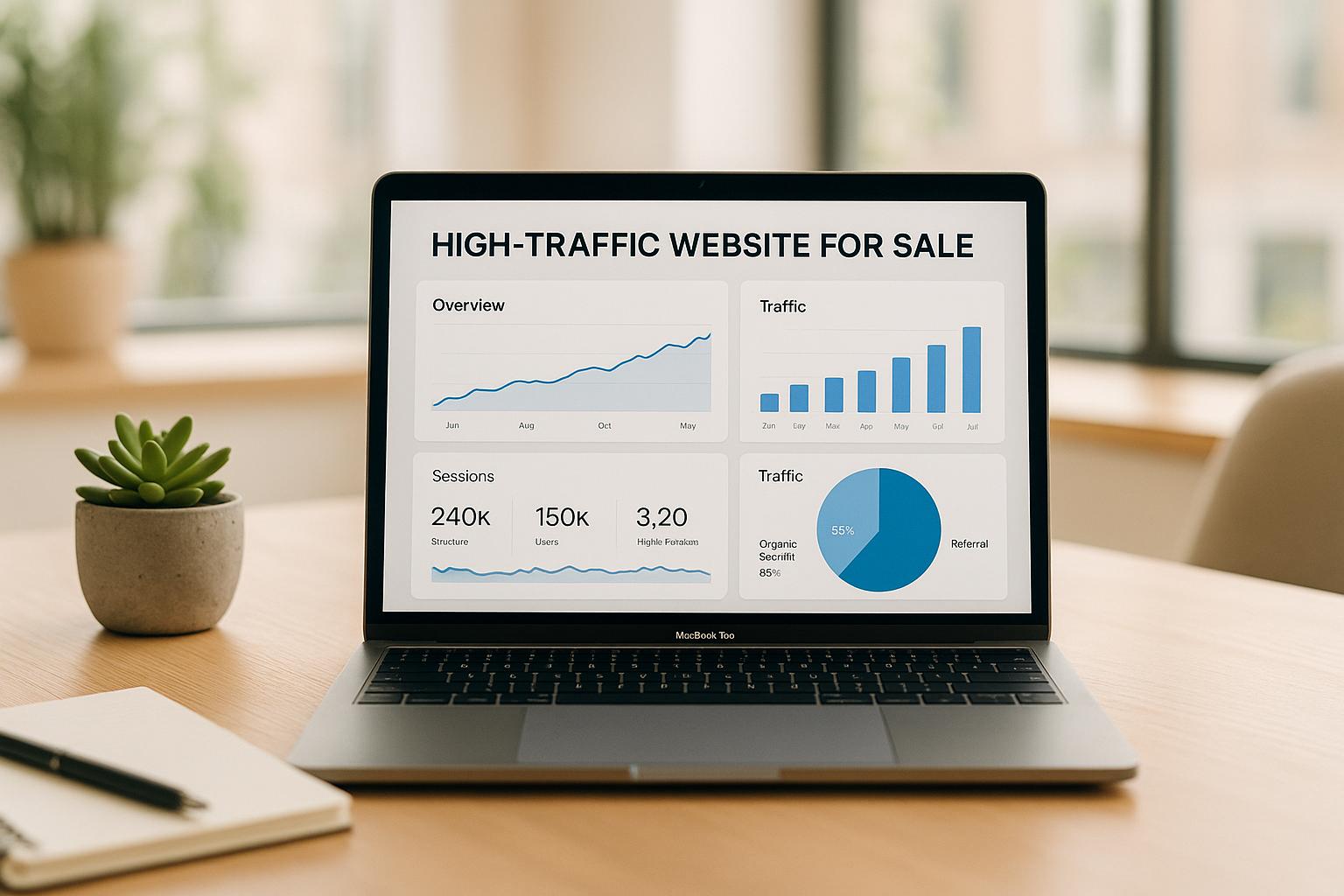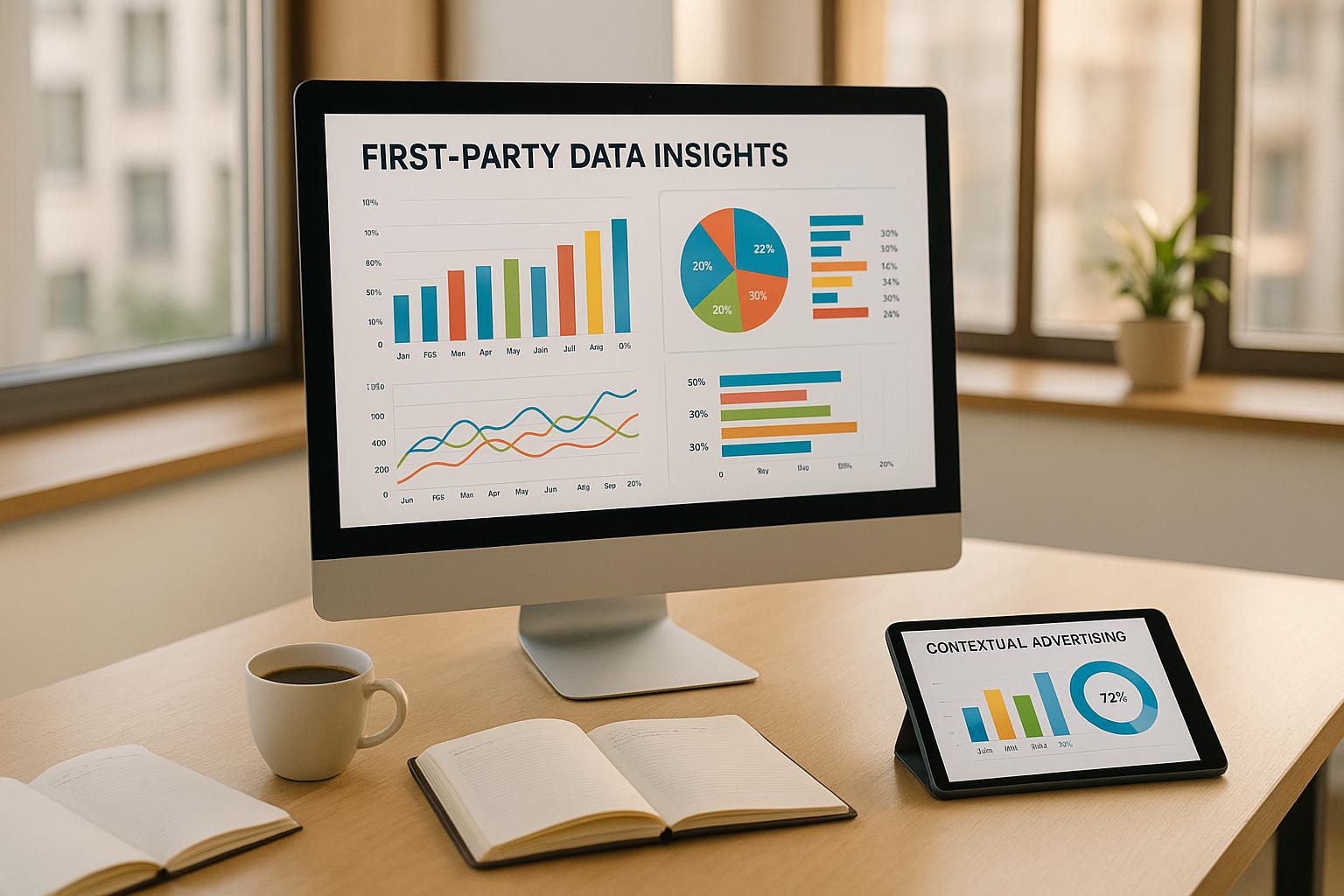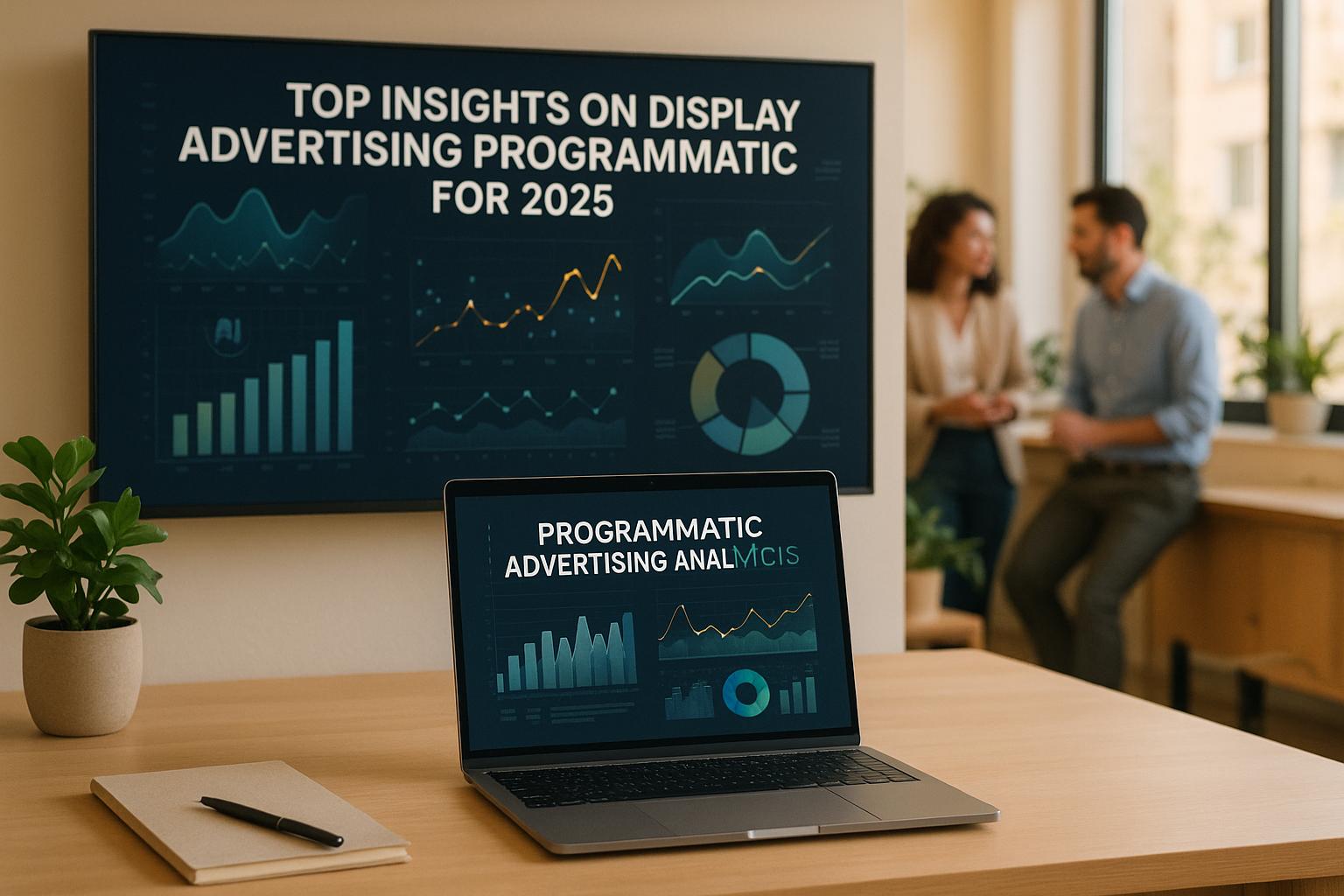Mobile advertising is booming in 2025, with in-app ad spend projected to reach $462.30 billion by 2027. Staying ahead means understanding the latest trends and tools shaping the industry. Here's what you need to know:
- AI-Driven Optimization: Platforms like Google Ads and TinyAdz use machine learning to target audiences more effectively and improve ROI.
- Privacy-First Approaches: With 79% of consumers worried about data usage, networks like Meta Audience Network and Unity Ads prioritize compliance with GDPR and CCPA.
- Cross-Device Integration: Connected TV (CTV) and mobile ad blending are unlocking new opportunities for seamless advertising.
- Advanced Targeting: From hyper-specific demographics to purchase intent, networks like AppLovin and TinyAdz offer precise targeting options.
- Diverse Monetization Options: Publishers can earn through formats like rewarded video ads, banner ads, and newsletter monetization.
Quick Comparison Table
| Network | Key Features | Best For | Privacy Compliance |
|---|---|---|---|
| TinyAdz | Hyper-targeted ads, verified traffic, AI-powered tools | Niche publishers and advertisers | GDPR/CCPA compliant |
| Google Ads | Smart Bidding, responsive ads, keyword targeting | Broad audiences, search campaigns | Privacy Sandbox, GPP |
| Meta Audience Network | Lookalike audiences, Advantage+ AI, cross-platform reach | Social media advertisers | GDPR/CCPA compliant |
| Unity Ads | Gaming-focused ads, rewarded video, real-time optimization | Game developers | GDPR/CCPA/COPPA compliant |
| AppLovin | Axon AI, MAX mediation, contextual targeting | E-commerce and mobile apps | GDPR/CCPA compliant |
These trends underline the importance of AI tools, privacy-first practices, and diverse monetization strategies in mobile advertising. Dive into the full article to explore how top networks are leveraging these innovations to deliver better results.
2025's BIGGEST Advertising Trends (And how to leverage them)
1. TinyAdz
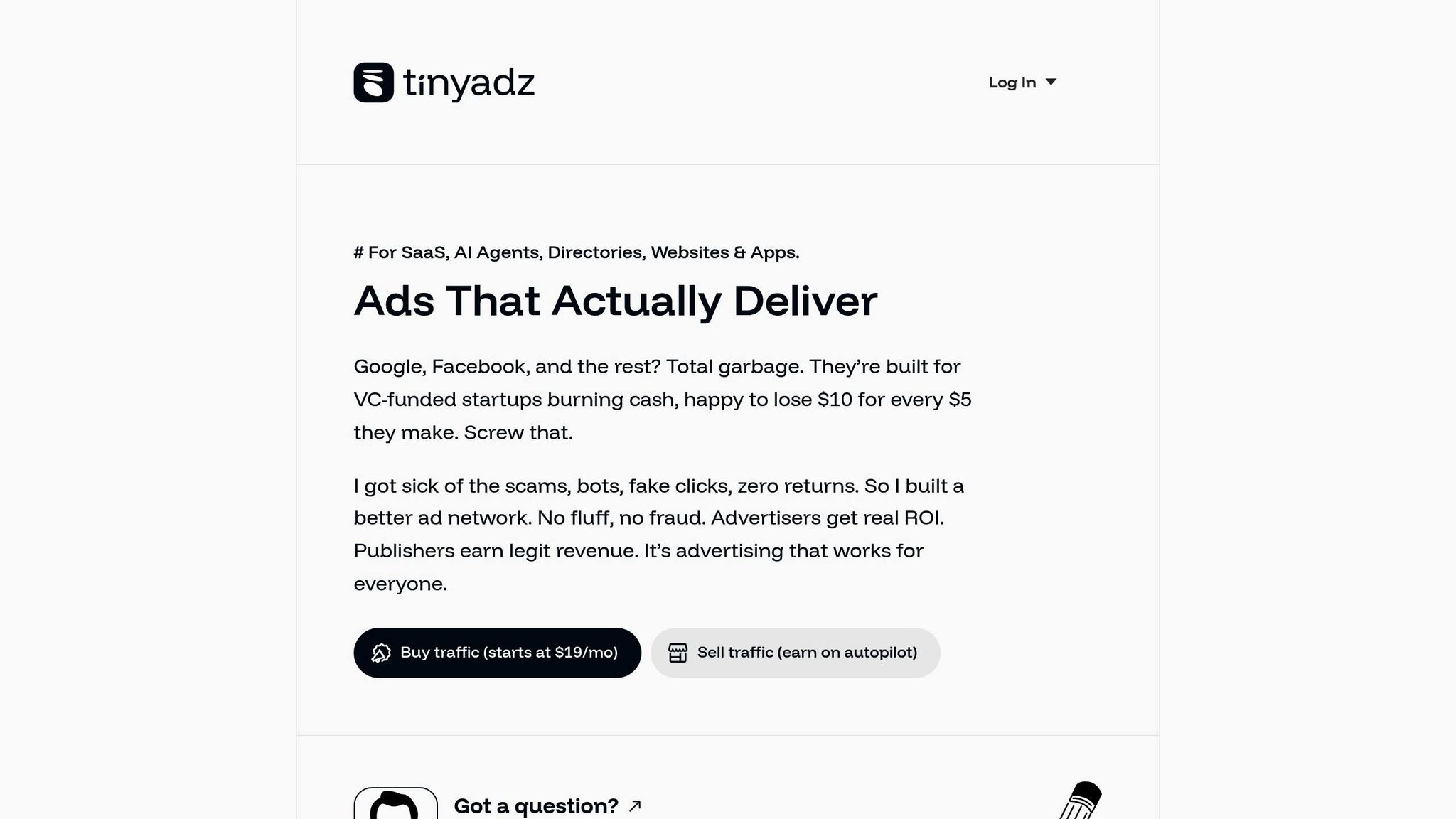
TinyAdz is making waves in the niche mobile advertising scene, aligning perfectly with the trends shaping 2025. The platform specializes in connecting targeted audiences with trusted publishers across various channels like websites, social media, newsletters, and even events. Best of all, it guarantees only human impressions, giving advertisers the confidence that their campaigns reach real people.
Ad Targeting Capabilities
When it comes to audience targeting, TinyAdz goes the extra mile. Its tools allow for precise demographic targeting, covering everything from age groups (13–17 to 55+), gender, and even specific locations like cities or Designated Market Areas (DMAs) in the U.S. For an added layer, advertisers can focus on household income and spending habits based on purchase behaviors.
But it doesn’t stop there. TinyAdz offers advanced targeting options like interests (such as gaming) and purchase intent, identifying users actively researching products or services. Behavioral targeting dives into recent in-app activity, while hashtag targeting zeroes in on users engaging with specific content over the past week.
Other features include targeting by connection type (WiFi, 2G–5G), operating system, device model, and pricing tier. Plus, the platform’s smart targeting tool suggests the best combinations of interests and behaviors to maximize conversions. These robust tools not only make ad campaigns more effective but also help publishers boost their revenue strategies.
Monetization Options for Publishers
TinyAdz provides publishers with numerous ways to earn. Traditional banner ads remain a staple, while directory monetization allows publishers to profit from curated content lists. The platform also supports monetizing all-site traffic, ensuring publishers can capitalize on their entire online presence.
Social media monetization opens up revenue opportunities on platforms like Instagram, Twitter, and TikTok. Publishers can also tap into their email subscriber base with newsletter monetization or generate income from events like conferences. TinyAdz ensures that all campaigns are carefully matched to the publisher’s audience, avoiding spammy or irrelevant ads. This flexibility lets publishers choose ad formats and campaigns that align perfectly with their content, creating a better experience for users and maximizing earnings.
Privacy Compliance Features
With online privacy being a top concern - especially for 80% of APAC users - TinyAdz makes it a priority. The platform collects only the data necessary for effective ad targeting and is transparent about how that data is used. It also stays ahead of evolving privacy regulations by adopting frameworks that require clear consent and full transparency in data collection.
TinyAdz implements proper consent mechanisms, secures data storage, and provides detailed reports on how user information is handled. This commitment to privacy not only protects users but also ensures that advertisers and publishers can trust the integrity of their campaigns.
AI-Driven Optimization Tools
TinyAdz leans on artificial intelligence to take campaign performance to the next level. Its AI algorithms analyze user behavior and engagement, optimizing ad placements in real time. The platform’s smart targeting system uses machine learning to pinpoint high-converting audience segments and adjusts campaign settings automatically to maximize return on investment (ROI).
Detailed reporting tools provide advertisers with clear insights into their campaigns, allowing for data-driven tweaks and improvements. This AI-powered approach ensures ads reach the right people while maintaining the platform’s focus on niche, authentic connections. TinyAdz stands out in the crowded mobile advertising space by combining advanced technology with a commitment to quality and precision.
2. Google Ads
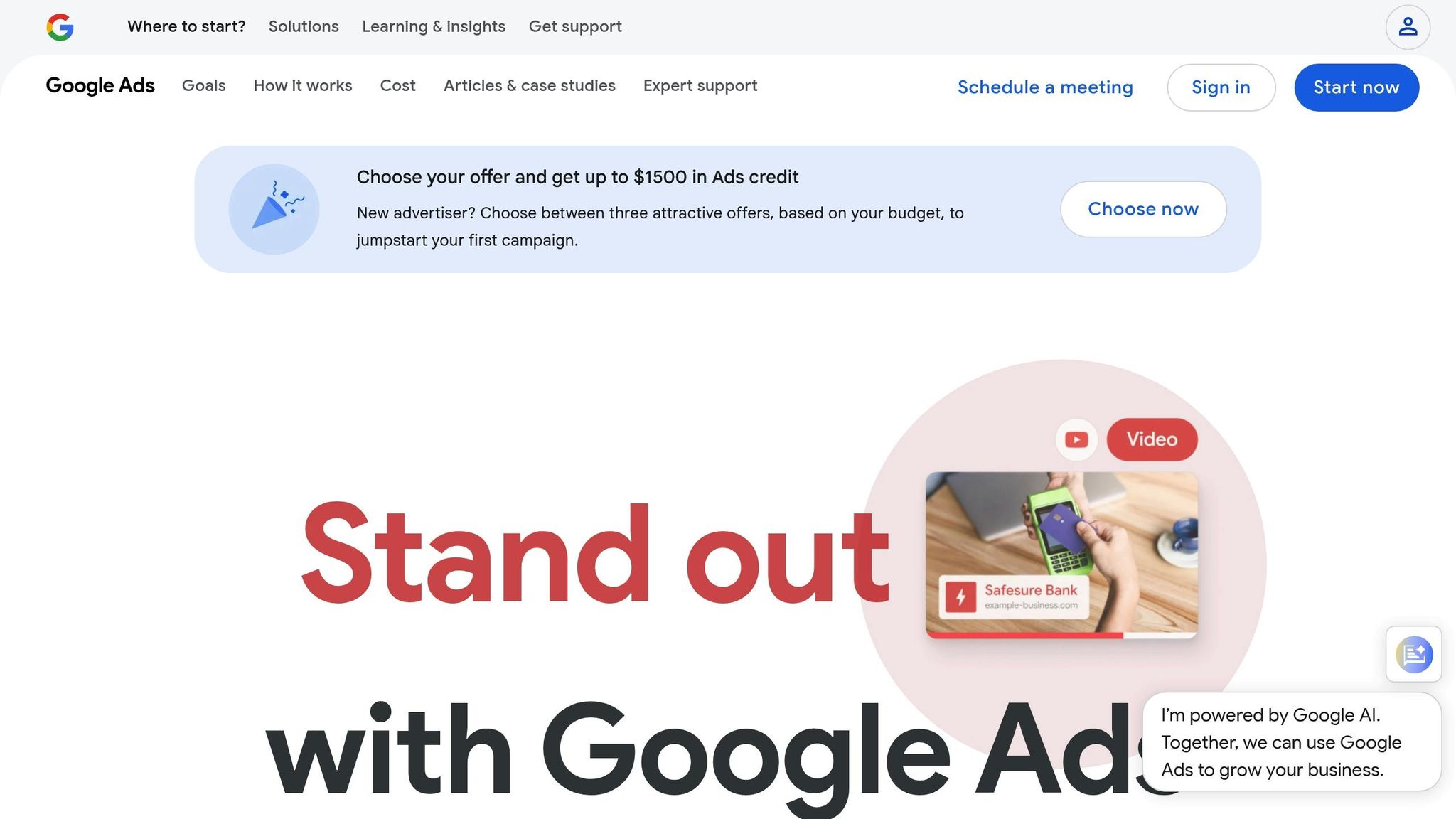
Google Ads stands out in the world of mobile advertising, offering tools that help advertisers connect with highly specific audiences while giving publishers effective ways to generate revenue. The platform combines audience segmentation, privacy-focused features, and AI-powered ad optimization to meet the demands of modern advertisers.
Ad Targeting Capabilities
Google Ads provides a range of targeting options, grouped into four categories: Google's audience segments, your data segments, custom segments, and others. These options include demographic details, affinity groups, in-market interests, and life events. For advertisers focusing on retargeting, your data segments allow campaigns to reconnect with users based on past interactions across websites, apps, or YouTube. Custom segments let advertisers go further, targeting users based on specific search terms, visited websites, or app usage.
For mobile campaigns, device targeting ensures ads are tailored to the user’s device, with advanced features available for formats like Demand Gen, Display, and Video. Adding call assets to mobile ads can boost click-through rates by 4–5%. Together, these tools enable advertisers to craft precise, high-performing campaigns while publishers can use them to drive revenue across multiple channels.
Monetization Options for Publishers
Publishers in the Google Ads ecosystem have several ways to earn revenue. Google AdSense, for instance, allows publishers to generate income from ad clicks or impressions, offering a 68% revenue share globally. For larger publishers who require more control, Google Ad Manager provides a robust platform to manage multiple demand sources.
To further increase earnings, publishers can use responsive ad units, analyze performance data, conduct A/B testing, and implement header bidding, which invites multiple demand sources to compete for ad placements. These monetization strategies, paired with privacy-focused measures, create a reliable and effective way for publishers to maximize their ad revenue.
Privacy Compliance Features
Google Ads incorporates features to help advertisers and publishers comply with regulations like GDPR and CCPA. For example, the platform includes restricted data processing (RDP), which limits how personal information from California residents is used for personalized ads. Under this system, Google operates as a service provider, adhering to strict data handling rules.
To give users more control, Google supports the IAB Tech Lab’s Global Privacy Platform (GPP) and offers tools like My Ad Center and My Account for managing ad preferences. A notable case in May 2025 saw the California Privacy Protection Agency fine retailer Todd Snyder $345,000 for failing to respect opt-out requests for targeted advertising. Advertisers can avoid similar issues by enabling restricted data processing for California-based campaigns, updating privacy policies, offering clear opt-out options, and regularly auditing third-party scripts and trackers.
"We are always working to stay compliant, which helps make compliance easier for your business".
AI-Driven Optimization Tools
Google Ads uses artificial intelligence to fine-tune bids, placements, and targeting, ensuring campaigns deliver strong results and a better return on investment (ROI). These AI tools process vast amounts of data in real time, adjusting campaign settings to reach the right audiences at the best times and prices. Features like Smart Bidding and responsive ads simplify campaign management by automatically modifying bids and ad formats, reducing the need for manual adjustments while improving overall performance.
3. Meta Audience Network
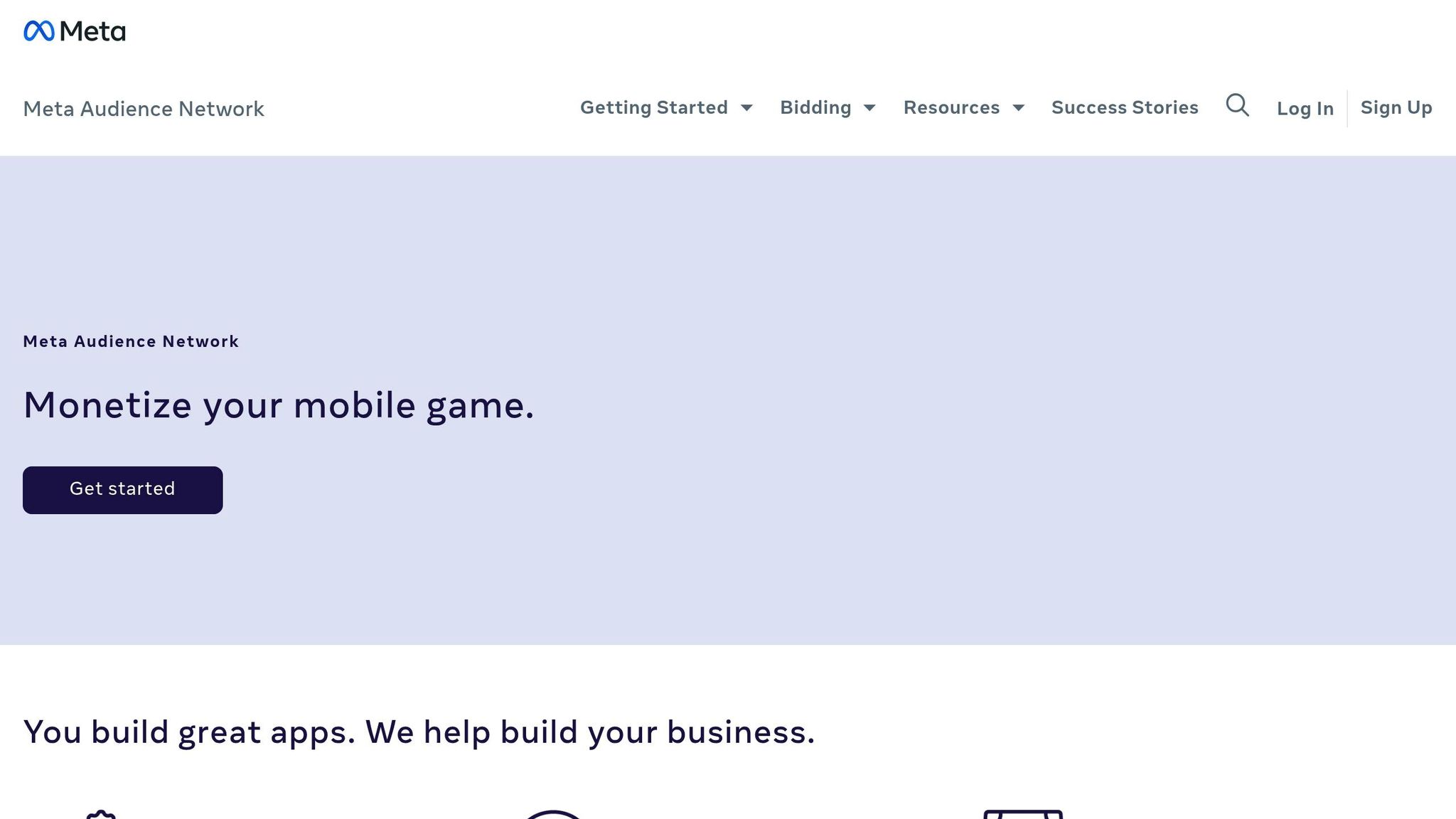
Meta Audience Network expands Facebook’s advertising reach beyond its own platforms, connecting advertisers with audiences across a vast network of mobile apps and websites. With over 1 billion ad views processed every month, it offers targeting options similar to those on Facebook itself.
Ad Targeting Capabilities
Meta Audience Network provides four main targeting categories: demographic, interest-based, behavioral, and engagement-based targeting. These tools allow advertisers to zero in on specific audience segments. Additionally, advertisers can use lookalike audiences to target users whose interests and behaviors align closely with their current customer base.
The platform also features Meta Advantage+ audiences, which utilize machine learning to automatically identify and target high-value users. Tests have shown that campaigns using Advantage+ audiences without detailed targeting exclusions achieved a 22.6% lower median cost per conversion compared to those with exclusions. However, changes are coming: starting June 23, 2025, Meta will consolidate detailed targeting interest options into broader groupings, and the ability to exclude specific interests was removed as of March 31, 2025.
Monetization Options for Publishers
Publishers can monetize their mobile apps by displaying ads from Meta’s extensive advertiser base. The platform supports four key ad formats designed to integrate smoothly into mobile experiences:
| Ad Format | Description | Best Use Case |
|---|---|---|
| Native Ads | Blend seamlessly into app content, matching its style | Content-heavy apps and websites |
| Banner Ads | Small ads placed at the top or bottom of the screen | Continuous revenue without disrupting flow |
| Interstitial Ads | Full-screen ads shown during natural app transitions | Gaming apps or between content sections |
| Rewarded Video Ads | Users watch ads in exchange for virtual rewards | Gaming and utility apps |
Publishers can manage monetization through the Monetization Manager in Meta Business Manager, which provides detailed tracking and optimization tools. Social media ad spending in the U.S. is expected to hit $82 billion by 2025, with Facebook capturing over 80% of the market. Campaign data reveals that combining Audience Network placements with Facebook and Instagram newsfeed ads can boost conversion rates by up to 8 times. For example, Bombas saw a 20% higher return on ad spend and a 13% lower cost per acquisition after incorporating Audience Network into its campaigns.
To maximize revenue, publishers should:
- Use the latest Audience Network SDK.
- Include Facebook entries in their ads.txt and app-ads.txt files.
- Regularly monitor ad implementation quality.
Privacy Compliance Features
Meta Audience Network is equipped with privacy tools to meet GDPR, CCPA, and COPPA requirements. Publishers are required to maintain clear privacy policies that outline their data practices. The Limited Data Use (LDU) feature, introduced in July 2020, allows businesses to restrict how Meta processes data for California residents under CCPA guidelines.
"This feature enables businesses to choose whether or not to apply restrictions to Facebook business tools data from California... When partners implement limited data use, we will use personal information that they share about people in California subject to our state-specific terms." – Facebook Product Manager
The platform also offers consent management tools, enabling users to opt in or out of specific data processing activities. Users can easily manage their data, including simplified account deletion options that remove their information from Meta’s systems. Publishers can enable LDU across various Meta tools - like the Facebook Pixel, Server-Side API, and Audience Network SDK - with regular data audits ensuring compliance with retention policies.
AI-Driven Optimization Tools
Meta Audience Network integrates machine learning through its Advantage+ audience system, which automatically identifies high-value users without requiring manual input. This system continuously learns from campaign data, refining targeting to improve conversion rates and reduce costs.
"Audience Network lets you extend your ad campaigns beyond Facebook to reach your audiences on websites and apps across devices such as computers, mobile devices and connected TVs." – Meta Business Help Center
sbb-itb-957fd63
4. Unity Ads
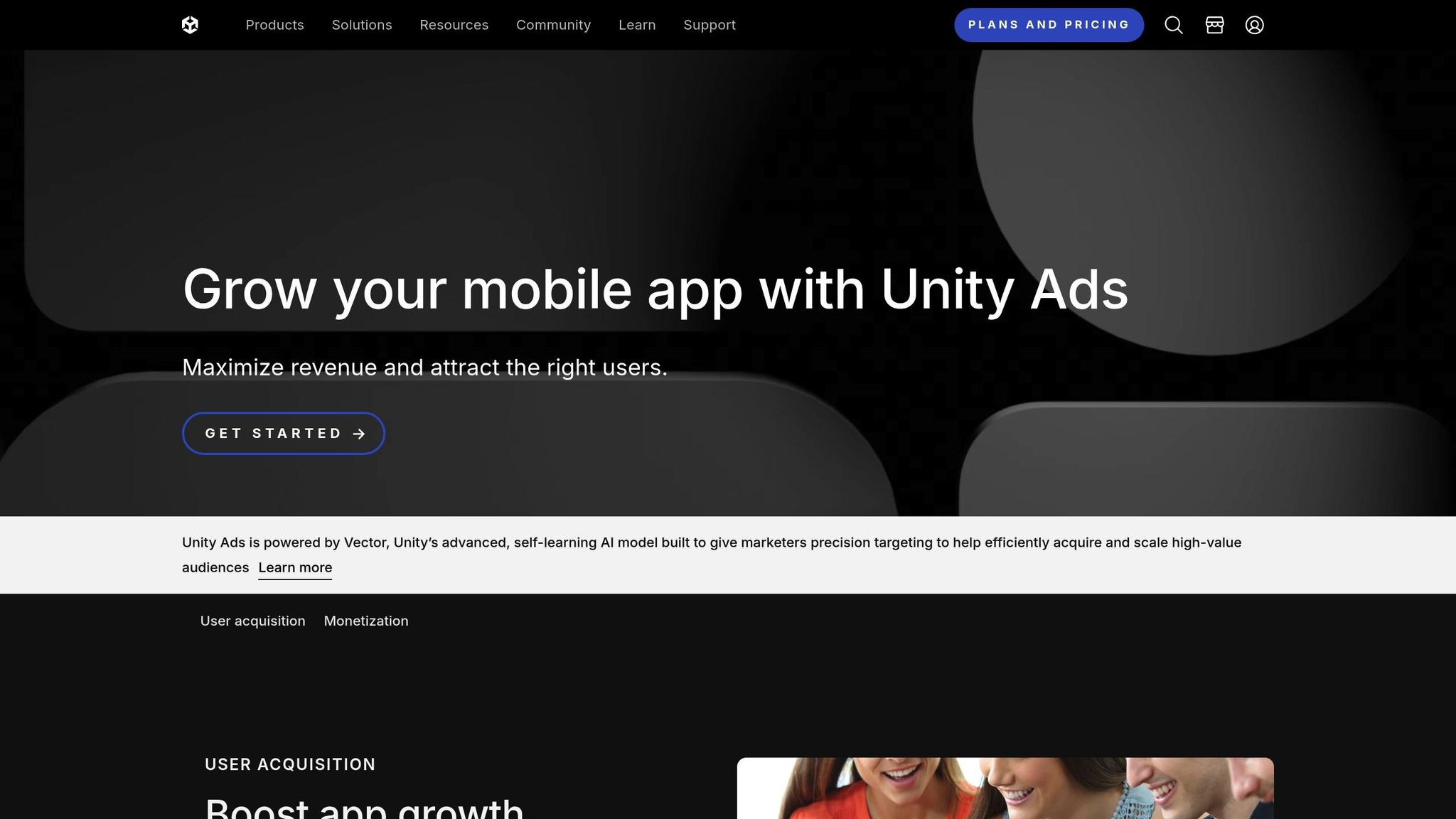
Unity Ads is a major player in mobile gaming advertising, reaching an astonishing 1.5 billion unique users worldwide. That’s about 20% of the global population! The platform processes over 100 billion ad impressions every month across thousands of Unity-powered games.
Ad Targeting Capabilities
Unity Ads operates as both a Demand-Side Platform (DSP) and a Supply-Side Platform (SSP), offering advertisers powerful tools for real-time bidding and highly precise targeting. Its Vector AI model learns on its own to identify and engage high-value audiences effectively. Advertisers can fine-tune their campaigns by targeting users based on interests, demographics, device types, and location. The platform uses real-time data to optimize ad delivery, ensuring better results. Plus, its integration with Meta Audience Network takes interest- and behavior-based targeting to the next level.
But Unity Ads doesn’t stop at targeting - it also equips game developers with tools to maximize revenue.
Monetization Options for Publishers
For game developers, Unity Ads offers a variety of monetization options, including rewarded video ads, full-screen interstitials, and banner ads. With just one SDK, developers can connect to premium demand sources through the Unity Ads network and Unity Exchange, simplifying the setup process while increasing revenue. The platform’s compatibility with top mediation tools ensures that every ad impression delivers the highest possible value.
Game developers have seen real results with Unity Ads. Many report ARPDAU (average revenue per daily active user) increases ranging from 15% to 35%, along with better engagement across different monetization strategies . Unity Ads encourages publishers to integrate rewarded ads seamlessly into gameplay by offering players incentives like extra lives, in-game currency, or power-ups. Publishers can also use content filtering tools to align ads with their game’s genre, age rating, and theme.
Privacy Compliance Features
On top of its targeting and monetization capabilities, Unity Ads comes with a full suite of privacy compliance tools to meet GDPR and CCPA requirements. The platform provides built-in solutions for obtaining user consent and APIs for custom consent flows. Publishers can control ad personalization using consent flags: if consent == "true", personalized ads are shown; if consent == "false", only non-personalized ads are displayed.
For GDPR compliance, SDK versions 2.0 and above automatically present opt-in options for targeted ads to users in the European Economic Area. Older SDK versions default to showing contextual ads. For CCPA compliance, the SDK includes automatic age-gated consent flows for users in California.
In July 2023, Tessellation, the developer behind Tiny Bubbles, implemented consent dialogues across SDKs to simplify privacy compliance. This streamlined approach helps publishers stay ahead of evolving privacy regulations while maintaining user trust.
5. AppLovin
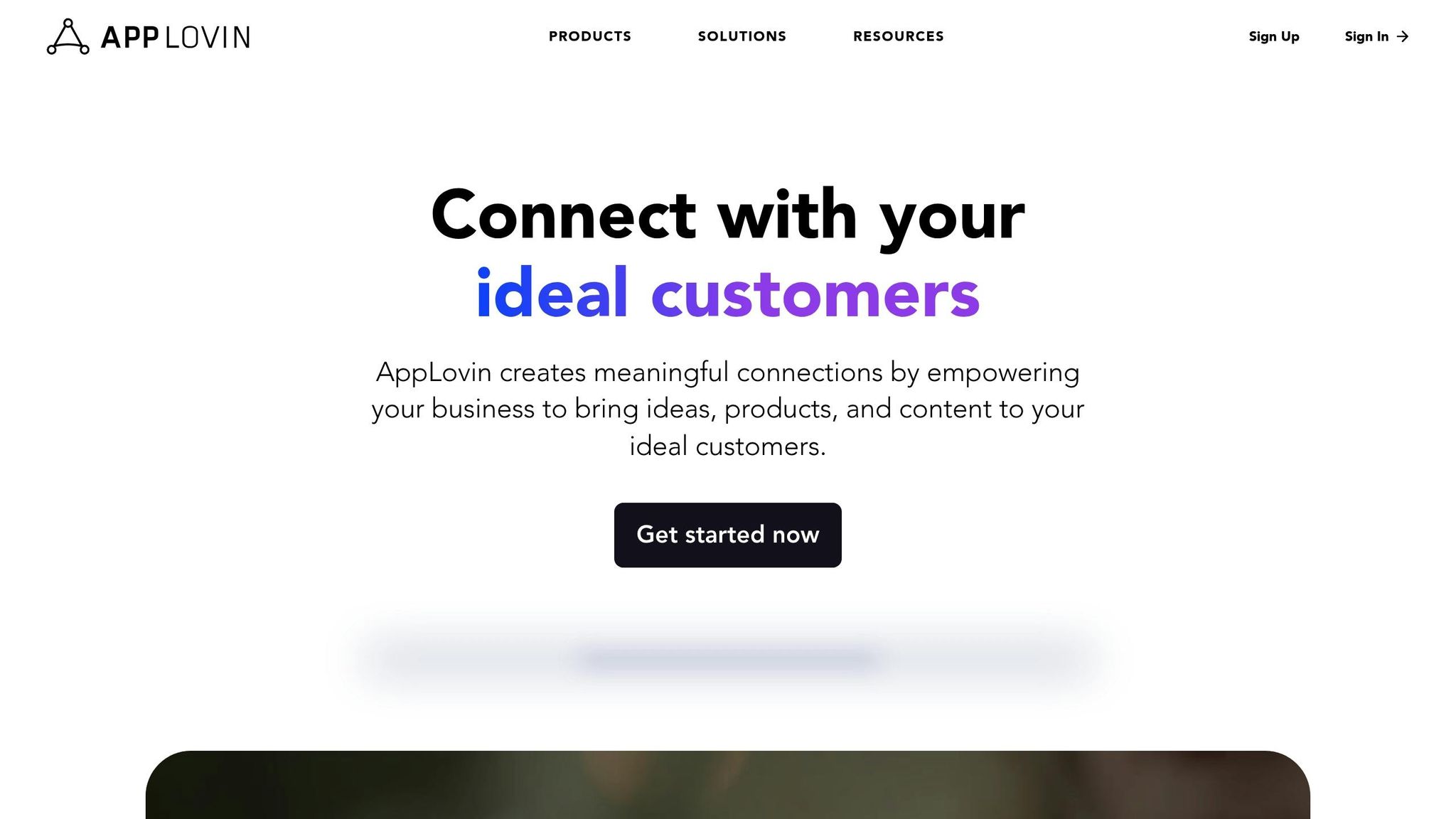
As mobile advertising shifts toward hyper-targeted, AI-powered strategies, AppLovin has emerged as a leader, offering tools that cater to every aspect of this fast-changing market. With a reach of 1.4 billion daily active users worldwide, AppLovin has become a vital growth platform, particularly for ecommerce brands aiming to expand their mobile footprint.
AI-Powered Optimization Tools
Central to AppLovin's success is its Axon AI engine, introduced in early 2023. This machine learning tool matches ads to users in real time, while its SparkLabs creative tools have shown to improve performance by up to 250%. Together, these features enable AppLovin to deliver precise, real-time ad optimization.
Advanced Ad Targeting
AppLovin's AppDiscovery platform takes ad targeting to the next level by using AI to identify audiences with the highest likelihood of conversion, minimizing wasted ad spend. It doesn’t stop at basic demographics; instead, it analyzes real-time user behavior and contextual signals for more precise targeting.
The platform offers two standout targeting options:
- Contextual Ad Targeting: Uses data from host media to customize ad content.
- App Targeting: Relies on app metadata and device details when device IDs are unavailable.
For example, DealDash's CPP campaigns in February 2025 saw a 71% increase in Day 7 ROAS and a 22% reduction in CPP. Similarly, the cashback app Upside achieved remarkable results with Cost Per Event (CPE) campaigns, which accounted for 40% of its total installs, delivered a 20x boost in ad spend efficiency, and reduced CPE by 85% in just one month.
Publisher Monetization Tools
AppLovin extends its capabilities to publishers with tools designed to maximize revenue. The MAX mediation platform connects app developers to a global advertiser network through programmatic auctions, optimizing eCPM rates and revenue using various ad formats and machine learning–driven analytics.
In addition, Lion Studios, a division of AppLovin, supports smaller companies with technical, creative, and marketing expertise. This includes A/B testing to refine ad placements, formats, and frequency, helping developers reach broader audiences.
Commitment to Privacy
AppLovin prioritizes privacy by adhering to GDPR and CCPA standards. Users can opt out of interest-based advertising directly within AppLovin-served ads. The company also complies with international frameworks such as the EU-U.S. Data Privacy Framework and its UK and Swiss extensions, with dedicated privacy representatives in the EU and UK to ensure compliance.
In a significant move, as of June 2024, the AppLovin SDK no longer collects geolocation data, reinforcing its privacy-first stance. Data retention is capped at 2 years, and international transfers are governed by Standard Contractual Clauses. AppLovin also offers a Privacy Management Application, allowing users to manage their data and respect consent signals.
Network Comparison Table
Selecting the right mobile ad network is crucial for shaping your monetization and advertising strategies. The table below highlights key features, tools, and limitations to help you make an informed decision.
| Network | Key Ad Formats | AI/ML Tools | Targeting Capabilities | Privacy Compliance | Monetization Features | Notable Limitations |
|---|---|---|---|---|---|---|
| TinyAdz | Banner Ads, Directory Ads, Social Media Ads, Newsletter Ads, Event Ads | Personalized Matchmaking Algorithm | Hyper-targeted niche audience matching, Verified traffic filtering | GDPR/CCPA compliant | All-site traffic solutions, No minimum traffic requirements | Limited to niche publishers and advertisers |
| Google Ads | Search, Display, Video, Shopping, App Install | Smart Bidding, Performance Max, Responsive Search Ads | Keyword-based, Demographics, User behavior, Intent signals | Privacy Sandbox, Consent management | Google AdSense integration, Multiple revenue streams | High competition, Complex interface |
| Meta Audience Network | Native, Banner, Interstitial, Rewarded Video | Advantage+ campaigns, Dynamic ads, Lookalike audiences | Interest-based, Behavioral, Custom audiences, Lookalike targeting | Data use policy compliance, User consent tools | Cross-platform reach (Facebook, Instagram, WhatsApp) | Requires Facebook Business account |
| Unity Ads | Rewarded Video, Interstitial, Banner, Playable | Machine learning optimization, Creative testing tools | Gaming audience focus, In-app behavior, Device targeting | COPPA compliant, Regional privacy laws | Mediation platform, Cross-promotion tools | Primarily gaming-focused |
| AppLovin | Native, Banner, Interstitial, Rewarded Video | Axon AI engine, SparkLabs creative tools | AI-driven audience prediction, Contextual targeting, App targeting | GDPR/CCPA compliant, 2-year data retention limit | MAX mediation platform, Lion Studios support | Complex setup for smaller developers |
This table provides a quick overview of what each network offers. Next, let’s dive into how these networks perform in terms of engagement, cost efficiency, and real-world results.
Organizations that integrate AI into their advertising strategies report an average 76% increase in ROI compared to traditional methods. Across the platforms, AI-powered tools have become a major game-changer, driving better results through smarter optimization.
For example, rewarded video ads boast completion rates as high as 90%, while native ads deliver 53% higher view rates. Additionally, AI-driven tools can slash customer acquisition costs by 30% and boost conversion rates by 40%. These stats underline the potential value of networks equipped with advanced AI capabilities, even if they come with higher initial costs.
Monetization strategies also vary across platforms. TinyAdz, for instance, caters to smaller publishers by removing minimum traffic requirements, making it an accessible choice for those just starting out. On the other hand, AppLovin's MAX mediation platform is tailored for larger developers with more complex needs. Google AdSense remains a versatile option, accommodating a wide range of content types and traffic levels.
With mobile traffic now accounting for 61.95% of overall web traffic and global ad spend projected to exceed $240 billion by 2025, choosing the right network is more important than ever. The insights above reinforce the importance of aligning your network choice with your long-term goals, ensuring a strong position in the ever-evolving mobile advertising landscape.
Conclusion
Mobile advertising is changing fast, with global digital ad spending expected to top $700 billion by the end of 2025. This growth demands strategies that align with shifting consumer expectations.
One key factor is personalization. Research shows that 71% of consumers expect personalized experiences, and 76% feel frustrated when they don’t get them. Even more telling, personalized offers encourage 45% of shoppers to complete their online purchases. This is why platforms like TinyAdz focus on hyper-targeted audience matching, while other networks rely on advanced AI tools for dynamic personalization.
"AI-powered, privacy-first personalization will become the cornerstone of effective marketing strategies." – Aman Sareen, CEO of Aarki
At the same time, privacy-first practices are essential for building trust - and trust leads to revenue. According to Cisco’s 2024 Data Privacy Benchmark Study, 95% of businesses found their privacy investments delivered returns, with an average of $160 earned for every $100 spent.
Another powerful tool is AI automation, which can streamline campaign management and reduce errors. Whether you’re a small publisher using TinyAdz’s matchmaking algorithms or a larger enterprise adopting sophisticated AI solutions, these tools can elevate your performance and efficiency.
With mobile commerce projected to make up 44.2% of retail e-commerce by 2025, choosing the right network and tools has never been more important. By combining hyper-targeted strategies with AI-driven solutions, advertisers can maximize their ROI while respecting user privacy.
The future of mobile advertising belongs to those who embrace cutting-edge technology while prioritizing user trust. Start by evaluating your current strategies, experimenting with AI-powered tools, and adopting privacy-first data practices. These trends aren’t just forecasts - they’re actionable steps toward long-term success in mobile advertising.
FAQs
How are AI-powered tools reshaping mobile advertising in 2025?
AI tools are transforming mobile advertising in 2025 by providing real-time insights into user behavior and preferences. This allows advertisers to craft highly targeted campaigns that resonate with their audience. Using advanced algorithms, these tools analyze audience data and fine-tune ad placements, ensuring the right message reaches the right people at the perfect moment.
Another game-changer is dynamic ad customization. For example, AI can seamlessly incorporate positive user reviews into ad content, making it more engaging and relatable. By tapping into AI-driven community intelligence, brands can make ads more relevant, boost performance, and see a stronger return on investment (ROI).
What privacy measures are mobile advertising networks using to address consumer concerns?
Mobile advertising networks are stepping up their privacy game by using AI-powered security tools, establishing straightforward user consent processes, and aligning with state and federal privacy regulations like the CCPA and GDPR. These steps are designed to boost transparency and safeguard user information.
On top of that, many networks are turning to privacy-focused technologies - think anonymized data handling and reduced tracking techniques. These approaches aim to ease consumer worries about privacy while still delivering targeted advertising that works.
What strategies can publishers use to maximize revenue from mobile advertising?
Publishers can boost their revenue by tapping into ad mediation platforms. These platforms link publishers to various ad networks, increasing fill rates and encouraging competitive CPMs as advertisers bid for inventory. It’s a smart way to ensure no opportunity goes to waste.
Using hybrid monetization strategies is another great approach. Mixing in-app ads, subscriptions, and in-app purchases creates a more balanced income stream. On top of that, advanced ad formats, like rewarded video ads and native ads, not only enhance user engagement but also drive higher earnings.
To take things a step further, integrating AI-driven tools can fine-tune targeting and ad placements, ensuring publishers get the most out of their ad inventory. It’s all about working smarter to maximize returns.
